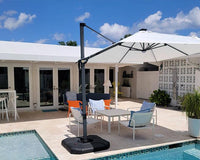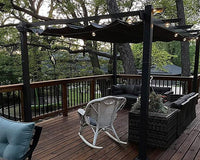Are you looking to make your backyard nicer and more usable? Have you been staring at pictures of nice wooden things covered with vines or small cozy retreats and said, "I want one of those!"
Then you start hearing confusing terms such as: pergola, gazebo, and arbor. They all sound alike, but they are really distinct things that are used for different purposes. This guide will simplify it all, uncover what distinguishes each one, and help you choose which backyard structure is perfect for your home and lifestyle.
The Pergola Can Define Your Outdoor Room
The first thing you should know about a pergola is its roof—or rather, that it does not have a solid roof.
The roof is open with slats, so there's a special light and shadow effect. It's not going to keep you completely dry if it rains, but it does offer some shade and makes a sunny area more bearable. Pergolas are usually built over a patio, deck, or walkway to create the feeling of being more enclosed without blocking out the sky. Their open design is ideal for supporting climbing plants. Think of lovely wisteria, climbing roses, or grapevines making their way up through the pergolas. This turns the structure into a living part of your garden that gets more gorgeous as time goes on.

The Gazebo Serve as Your Backyard's Centerpiece
Now, let’s talk about the gazebo. If a pergola is an open-air room, a gazebo is a freestanding, fully-covered outdoor room. It will bring more beauty and functionality to your outdoor space. Think of the classic octagonal (eight-sided) structure you might see in a park, often with a little bandstand inside. That’s a gazebo. While octagonal is the classic shape, they can also be round, square, or rectangular.
The key feature of a gazebo is its solid, continuous roof. This is what truly separates it from a pergola. A hardtop gazebo gives you full protection from the hot sun and surprise rain showers, making it a reliable spot for outdoor dining, hosting a small party, or housing a hot tub. It’s a true destination in your yard—a place you go to, rather than just pass through.
Gazebos often have built-in flooring and can even feature built-in seating, screens to keep bugs out, or railings around the sides. It's a much more substantial and enclosed structure than a pergola.

The Arbor Welcomes You into the Garden
Finally, we have the smallest and simplest of the three: the arbor. An arbor is best thought of as a garden doorway or a decorative archway. It’s a much smaller structure, typically just big enough for one or two people to walk through. It usually consists of two side panels (like a trellis) connected by a simple arched or flat top.
The main job of an arbor isn't to provide shade or shelter. Its purpose is almost purely decorative. It’s used to create a beautiful entrance to a garden, mark the beginning of a pathway, or act as a standalone feature to draw your eye. Like pergolas, arbors are fantastic for supporting climbing plants and are often covered in roses, clematis, or ivy, creating a romantic and whimsical feel. You wouldn’t put a table and chairs under an arbor; you walk through it.

Pergola vs. Gazebo vs. Arbor: A Simple Breakdown
Still a little fuzzy on the details? This simple chart breaks down the key differences at a glance, making it easy to compare them side-by-side.
| Feature | Pergola | Gazebo | Arbor |
| Main Purpose | To define a space, partial shade | To provide shelter, a gathering spot, like wedding | To create an entryway, decoration |
| Roof Type | Open, slatted rafters or beams | Solid, continuous roof | Arched or flat top, often open |
| Size & Shape | Usually square or rectangular | Usually octagonal, round, or square | Small, tall, and narrow |
| Placement | Over a patio, deck, or walkway | Freestanding in a yard or garden | At an entrance or along a path |
| Best For | Creating an outdoor "room" | Sheltered outdoor dining; relaxing | Framing a view or entrance |
Match the Structure to Your Home's Style
The right structure should feel like it belongs in your yard. Each one lends itself to different architectural and landscaping styles.
- Pergolas are incredibly versatile. A sleek, simple pergola made of dark wood or metal can look stunningly modern or minimalist. A more rustic, heavy-timber pergola can fit perfectly with a Mediterranean or farmhouse-style home.
- Gazebos have a more traditional and formal feel. The classic white, octagonal gazebo is a perfect match for a Victorian, Colonial, or traditional cottage-style home. They evoke a sense of timeless elegance and classic park-like charm.
- Arbors are the essence of romance and whimsy. They are right at home in an English country garden, a rustic cottage setting, or any landscape that aims for a soft, natural, and charming look.

Think About Cost and DIY Friendliness
Your budget and your comfort level with DIY projects will also play a huge role in your decision.
The arbor is by far the most budget-friendly and easiest to build. You can buy simple arbor kits at most home and garden stores and assemble one in an afternoon with basic tools.
A pergola sits in the middle. It's a more involved project that requires some solid building skills, especially when it comes to setting the posts correctly. However, a handy DIYer can definitely tackle a pergola kit over a weekend. The cost will vary widely based on the size and material (wood vs. vinyl vs. aluminum).
The gazebo is generally the most expensive and complex of the three. Because of its solid roof, integrated floor, and more complex shape, a gazebo is often a job best left to professional contractors. It's a significant investment in both time and money.

Pergola vs. Gazebo vs. Arbor: Which One Is Right for You?
Choosing between a pergola, gazebo, and arbor is all about asking yourself one simple question: "What do I want this structure to do?"
- If you want to create a defined outdoor living space with partial shade and a place for plants to climb, you want a pergola.
- If you need a fully sheltered spot to protect you from sun and rain for dining or relaxing, you want a gazebo.
- If you just want to add a charming, decorative entryway to your garden, you want an arbor.
Now that you know the difference, you can confidently choose the perfect structure to make your backyard dreams a reality.




